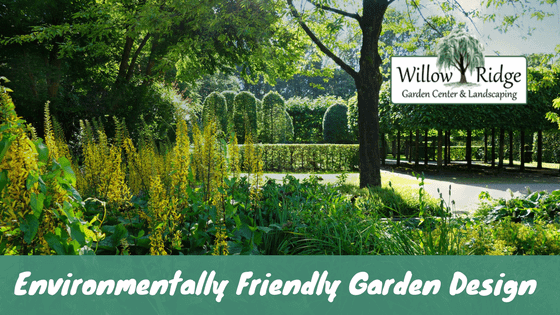Environmentally Friendly Garden Design
Your garden can help the environment by planning and planting with ecological functions in mind. Plants are really the most amazing of all life forms, without them there would be no animals. They create our oxygen rich atmosphere and changed carbon dioxide and water into the carbohydrates we call food. Also plants soften our impact on the environment that supports us. Using an environmentally friendly garden design and knowing which plants function well for providing homes and nourishment for pollinators, managing watersheds & sequestering carbon is important in sustaining the ecosystem where we live…Planet Earth!
Helping Pollinators
It’s obvious to everyone by now that flowering plants provide support for our pollinators, whose numbers are dwindling. Decline in Honey Bee populations make headline news, but also suffering are the 4,000 species of native bees that provided all the pollination for North America before Europeans imported the Honey Bee. Garden perennials to add to your landscape should include Yarrow, Bee Balm, Hyssop & Coneflowers to name just a few.
Managing Watersheds
We can also help manage our own local watershed with plantings that ensure the rain that falls on our own property slowly percolates into the soil. When rainfall soaks in, it is cleaned and will recharge our water table. If allowed to rapidly run off, it carries fertilizer & pesticides into streams & rivers. Select plants with deep fibrous root systems for your landscape. Use less turfgrass & more plants like Little Bluestem & Switch Grass, or ground covers like Pachysandra, Coral Bells or spreading ferns. These are better at holding rain water on site.
Sequestering Carbon
Another important ecological function of plants is their ability to capture harmful manmade Carbon from the atmosphere. They lock it into the soil, improving the soil health. You may think only big trees are of value in this regard, but on a per acre basis deep rooted, densly planted perennials remove as much as a forest, and up to 9 times more carbon than lawns. Replace some of your lawn with sweeping plantings of beautiful perennials.
The plants in your garden determine how many species of birds, butterflies, and other desirable wildlife can live on your property. Plants provide food for caterpillars (larval form of moths & butterflies) which are valuable because many creatures, especially birds depend on them for food. Planting perennials for attracting butterflies will provide for wildlife two fold.
Planting landscapes that help the environment is a goal we must strive for if we want our ecosystem running properly. The ecosystems that sustain US are all created by the plants and animals around us, and the more species that thrive, the better it will be.

